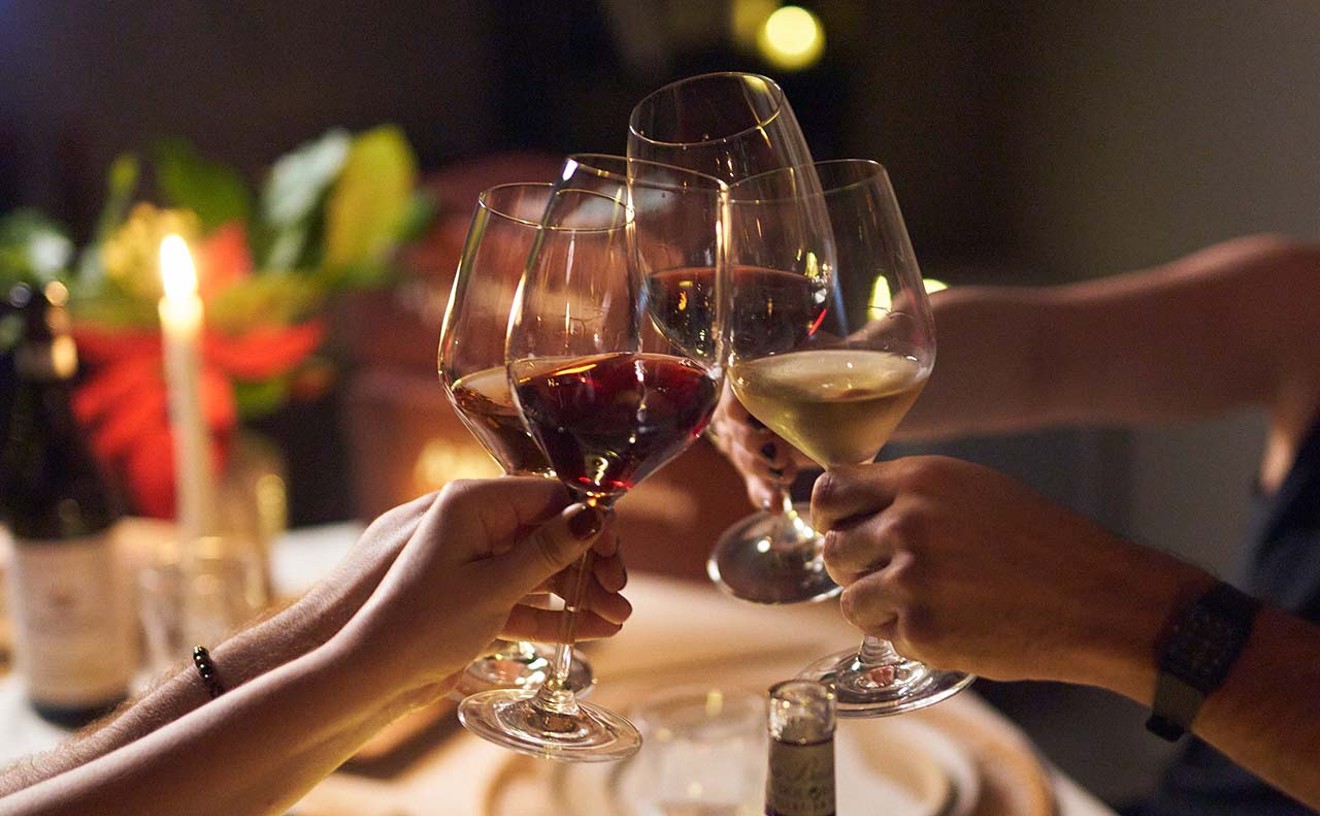"Yeah, we are. Surprised, though," said the proprietor, who obviously had no clue he was talking to my spouse. "That critic's a real ball-buster."
He's right. I am tough to please, and I don't offer any apologies for it. Though I enjoy nothing more than giving credit where credit is due, leave your cojones waving in the wind by serving bad food or providing awful service and you're bound to get whacked by any honest critic.
Unfortunately, it seems to me that upscale eateries are doing more wrongs than rights these days, and leaving their family jewels pretty vulnerable to attack. Worse, I think some restaurants don't want to change. No matter how many ostensibly well-meaning questions the staff or management asks about your comfort and experience, what they really want to hear is validation for what they've done. Watch a waiter's body language sometime: When he's half-turned to your table, that means he's not really listening, he's just on his way to the bar to pick up someone's drink order. See how startled he is when you reply frankly -- as I'm about to do -- that everything is far from fine.
"Any questions about the menu?"
I've raised the issue of incorrect grammar and punctuation before, but no one seems to be listening. As with any printed text, a menu should be spell-checked, proofread, and corrected. When I'm paying twenty bucks for an entree at Two Chefs, for instance, I expect to order risotto, not rissotto; gnocchi, not gnocci; Vidalia onions, not vadalia onions; caramelized shallots, not carmelized shalotts; and grilled shiitakes, not grilled shitakes.
True, most people don't notice. But a carefully prepared menu speaks to the level of dedication the chef and proprietors are putting into the dishes; one reflects the other. If a restaurateur hasn't got the time -- or the literacy -- to research his own menu, he should hire someone else to do it. That's what consultants are for.
While I'm on the subject, let's clear up another point. Crossing a chef's name off the menu with a magic marker is not the epitome of class. The Oval Room at the National Hotel on South Beach couldn't even keep this mistake consistent: A month after Marvin Woods (formerly of the short-lived Southern-food restaurant Savannah) was recruited to take over for executive chef Scott Swiderski -- a well-publicized move -- some menus still credited Swiderski at the bottom, while others featured an indelible black line. How dare they collect up to $17 for appetizers and $36 for main courses without shouldering the nominal burden of reprinting? Cost-cutting should start with charging less.
The Oval Room, however, might want to consider retooling the entire menu before rushing off to Kinko's. Expecting to dine on lip-smacking Southern cuisine a la Woods, I was surprised to find there wasn't a fritter in sight. The waitress confirmed that Woods is cooking Swiderski's menu. I can't understand the reasoning: Why bring in a name chef with a signature brand of cuisine and not utilize his talents?
"Who gets the fish?"
We've all shared the frustration of ordering dinner and then watching it get bungled, with the server placing dishes in front of the wrong recipients. Last week I wrote about the wonderful experience I had at Cafe Marquesa. I didn't have room to elaborate on the fine service, but it's probably worth sharing the management's method for remembering who gets what.
Every seat at a table is assigned a number, starting from the server's left and proceeding clockwise. That way a patron isn't ordering dinner, a seat number is. It's even entered into the computer that way: 1 gets the tuna, 2 the mango shrimp, and so on. If a dish is to be shared, all the seat numbers at the table are entered -- that means bring extra plates. No matter who delivers the food, no questions need to be asked.
Contrast that with the dinner I had the next night at Atlantic's Edge, the dining room at the posh Cheeca Lodge in Islamorada. Chef Dawn Seiber's fare was stunning, particularly her appetizer of pan-seared sea scallops with farm-raised hearts of palm and her main course of mojo-marinated veal chop over a yuca croquette with cilantro butter. The service was exceedingly polite and knowledgeable -- until the entrees arrived accompanied by the dreaded question: "Who gets what?"
Numbering seats, incidentally, isn't exclusive to fine-dining establishments. I learned the system when I waited tables in a touristy, family-style fish joint, and I found it invaluable in terms of earning tips. Of course, it didn't improve my short-term memory enough for me to find my car keys and drive home, but with all the extra cash I was making I could afford to take a cab.
"Ya still workin' on that?"
You never hear a server yelling, "Gimme some 'shrooms with that, Al baby!" when relaying an order at Chef Allen's, so how did "Still working on that?" enter the lexicon of acceptable eating-out interrogatories?
Banish it, I say, along with removing plates before the entire party is done with a course -- that's just plain rude. Another good rule of thumb: Take away appetizers before attempting to serve main courses. Back at Two Chefs, the server moved my friend's salad while she was still clutching her knife and fork, set down her "rissotto," then pulled the knife reproachfully from her hand. "You have a clean one right there," he chided, pointing to the side of her dinner plate. "This one is dirty."
Finally, every waiter in an upscale establishment should learn how to sweep off a table. My mother was so annoyed by the amount of debris that had accumulated between courses at Grove Isle that she swept it into the center of the table herself so the server couldn't pretend not to notice it. He saw it all right -- he put our dish of banana-chocolate chip ice cream squarely on top of the pile to hide it.
"Would you like to see our dessert tray?"
How anybody could find a puddled mass of unrefrigerated desserts appealing is beyond me. But although the dessert tray should have gone the way of shoulder pads and big hair, especially here in steamy South Florida, it has managed to linger, even in places like the Armadillo Cafe in Davie. Worse, the trays there are kept so close to the open kitchen that it's only a matter of minutes before they begin to melt. It doesn't do justice to the pastries -- the slice of chocolate pecan pie with fresh whipped cream was delicious, exponentially better than the soggy mess it appeared to be on the platter.
But then, the Armadillo could do with some other updates as well. Butcher paper over the tablecloths (accompanied by little jars of crayons) isn't even faddish in coffeehouses any more.
"How's everything?"
As far as I'm concerned, "Don't ask, don't tell" isn't just for the military. First of all, not everyone answers honestly. (I usually don't, because in my position I don't want to draw attention to myself.) But if servers are going to insist -- "No, really, how is everything?" -- they should at least have the decency to absorb the answer without rationalizing it. At one tiny Cuban cafe called Black Beans and Rice, we were asked what we thought of the honey-garlic chicken cutlet. Too sweet, and tough, we told our server, whereupon she (1) suggested that perhaps we didn't like honey and shouldn't have ordered it in the first place, and then (2) blamed the chicken press, which had allegedly crushed her two-year-old's fingers to a bloody pulp just the day before.
There are some things the diner simply doesn't want to know.
Better that the management unobtrusively attend to the customer's welfare throughout the meal: A positive experience is the only kind that induces a patron to return. Armadillo Cafe forgot that little fact when we dined there not long ago. In spite of our reservation, the hostess stuck us in the back banquet room, far removed in atmosphere from the vibrant, noisy dining room. Still, we didn't request a table change until the staff began preparing the rest of the room for a group of twenty.
"Is it going to be just one large party and us back here?" we asked our server.
"Yes," she answered, "but you'll be fine."
I begged to differ, and requested that we be moved to another table -- which is my prerogative. You'd have thought I'd asked for a complimentary bottle of Dom Perignon. After spending a half-hour at the bar, buying our own (delicious) watermelon margaritas, we were finally led to our new location.
"You'll probably think this is a bad table too, because it's near a door," the hostess tossed over her shoulder as she seated us. "But it's not."
Oh yeah? It's not a table I'd feel comfortable occupying again -- not as long as that sort of attitude comes with it.










